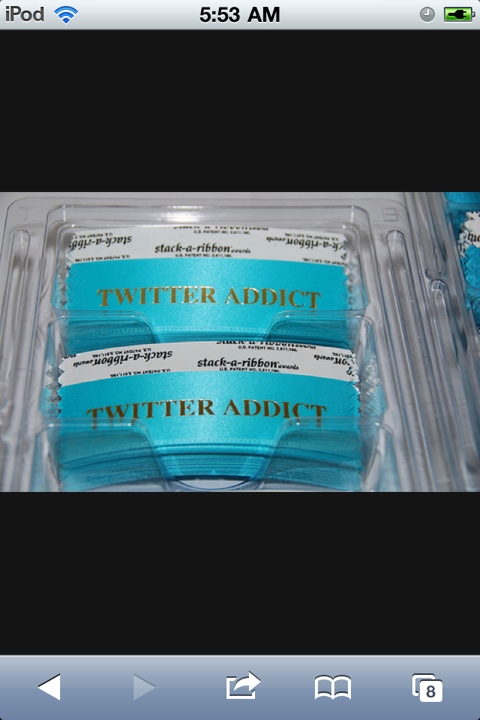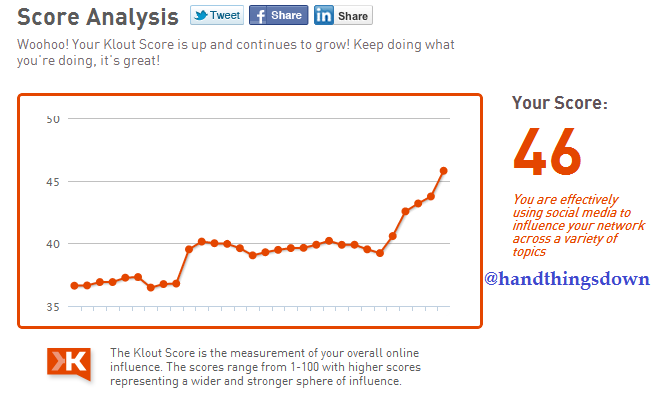 Even though a lot of people in the startup world can get by without exchanging tangible calling cards—using Bump to exchange contact information, for example—handing over an actual card can leave a longer lasting impression. I wrote about what to include on a business card in my other blog, focused on photography, and the business of photography, so I’ll simply reference it from here.
Even though a lot of people in the startup world can get by without exchanging tangible calling cards—using Bump to exchange contact information, for example—handing over an actual card can leave a longer lasting impression. I wrote about what to include on a business card in my other blog, focused on photography, and the business of photography, so I’ll simply reference it from here.
Archive for the ‘Marketing’ Category
Business Cards are Still Relevant
I Think, Therefore I Tweet #twitterjunkie
I am addicted to Twitter. There, I said it, admitting it is the first step, right? Over the last year, posting to Facebook has diminished, especially as I became more and more fascinated by Twitter. The biggest attraction is real-time news whether it’s what’s trending locally, articles about technology or startups, or conversations about my favorite topics. I love reading and consuming what’s going on, even if I do most of my reading late at night and into the wee hours of the morning.
I love sharing information and the conversations around various hashtags opens my mind to different ideas. During the work day, I limit information consumption so I can power through my to do list and have productive meetings. Yet the minute I get a free moment I’m compelled to check the feed to see what’s going on. Does anyone else feel this way? Hidden obsessive-compulsive tendencies?
It’s ok, if you don’t follow me. I tweet up to a hundred times a day which can be overwhelming to a casual user or anyone new to Twitter.
This is what I post:
- Content from startup or social media events.
- Content I’m reading, using Twitter to “bookmark” since it’s automagically backed up on Backupify.
- Conversations on the following hashtags: #startup, #leanstartup, #smcphx, #socialmedia, #UFC, #phxlatenite
- Random thoughts throughout the day.
- Checkins on Gowalla/Foursquare/Facebook/Google+
Here are the mobile Twitter apps I use for iPhone:
- Echofon – my favorite for browsing the feed and having twitter conversations.
- Smartr – to read articles tweeted by people I follow without the noise of the conversations.
Hootsuite – to schedule articles and shorten links.
- Tweetdeck – to post tweets longer than 140 chars, it’s laggy on my device so I use it very rarely.
- Twitter – I use this the least and can’t figure out why I haven’t deleted it.
What are your favorite Twitter apps? Who else is addicted to Twitter?

Image credit: Steve Rhodes
How to Trash Your Klout Score
I’ve been following a social experiment with great interest over the last couple of weeks. Merlin U Ward challenged himself to become influential over #futzing in Klout in 10 days. He chose a word that wouldn’t be used in normal conversation for his “scientific” experiment. At first, I ignored using the #futzing hashtag on Twitter, hoping it would go away because I didn’t know what it meant. I also had no desire to accidentally have #futzing attached to my name. When I realized I can hide word in Klout I decided to join in on the fun, as a by product my own Klout score raised 4 points over 30 days, even going up 1 point in the last 5 days.
I thought this was interesting since social media junkies are all slightly obsessed with raising Klout. I’ve never been one to follow the pack so why not do the exact opposite for 10 days?
In an effort to see the results of influence within Twitter, I disconnected my Facebook account which resulted in an immediate 2 point drop in Klout. Then I disconnected Linkedin to receive a 4 point drop in Klout to 52 points.
10 Day Plan
- Last tweets before going silent is to moderate the Social Media Club Phoenix Chat on how to separate your professional and personal life online on July 8 from 2:00 – 3:00 pm using the hashtag #smcphxchat
- Respond to @mentions on DM to reduce the number of tweets from my account to nearly zero over the next 10 days. This will be hard since I’ve recently switched to using Twitter to replace instant messaging and text messaging. Most of my conversations are public, I have no secrets.
- Don’t post any content I’m reading to Twitter, post directly to Linkedin.
Report back in 5 days with a screenshot showing the Klout score at that time.
If you want to follow this experiment, don’t forget to sign up to get it delivered to your mailbox or RSS reader. You can also follow on Twitter @CherylMarquez.
Klout score after disconnecting Facebook and before disconnecting Linkedin.

Klout score after disconnecting LinkedIn.

Note: This entire post was written on my iPod Touch in Evernote, then pasted into the WordPress app. This is why the screenshots of Klout are from an iOS device instead of the web.
Getting Press for Your Startup
 When we were in the Founder Institute at the beginning of the year, we had weekly milestones for customer development, market research, competitive analysis or product development to keep our business moving forward. The biggest aspiration we had at the time was to graduate. We worked our butts off to polish the pitch deck and get the 0.1 version of the Hand Things Down mobile app done during our last three-week sprint.
When we were in the Founder Institute at the beginning of the year, we had weekly milestones for customer development, market research, competitive analysis or product development to keep our business moving forward. The biggest aspiration we had at the time was to graduate. We worked our butts off to polish the pitch deck and get the 0.1 version of the Hand Things Down mobile app done during our last three-week sprint.
We naively thought, once we graduate we can get back to a normal life. Then as you hit each milestone, you take a breath, maybe catch up on a little sleep and start charging towards the next goal. Startups usually go into beta, then start scrambling to get press for their big launch. We were very lucky to receive our first mention in a Mashable article by Jolie O’Dell on the “5 Ambitious Social Good Startups Created in a Single Weekend” while we were busy with the private beta for Hand Things Down.
Before you begin tackling the tactics below to make a splash with your web startup, make sure you create a compelling story to make people want to share what your company’s story with their friends. Then give them a product they can’t live without so they keep telling their friends about it.
Top 7 things you need to do to launch a web startup, according to Robert Scoble on Quora:
- Get a LaunchRock site or create a landing page from WordPress using the LaunchPad theme to collect email addresses.
- Make a blog.
- Make a YouTube video channel.
- Start Tweeting.
- Get a Facebook Page.
- List your company on Angel List (and StartupLi.st, CrunchBase, etc).
- Figure out the 10 journalists you want to have seen your product before you launch.
- Be lucky…added by me
If you are creating your startup team, the ideal combination is to have one person focused on business and marketing while the other founder focuses on development. My primary focus has been on creating content for the blog, writing guest blog posts on websites that our target customer regularly visits and of course social media. Social media includes tweeting regularly on the company Twitter account, posting questions and content on the Facebook page and commenting on Facebook pages our target customer might read AS THE BUSINESS FACEBOOK PAGE. Do all of these marketing activities even before your company releases the product to build your online brand. Social media marketing takes a long time to gain traction. If you don’t have time to create your blog, create a landing page where you can collect email addresses of interested customers that you can market to when you start your beta.
I added number 8 because luck will play a part in how hard or easy it will be to get your company in the news. Since we participated in Startup Weekend, Founder Institute – Seattle, and continue to be active in the startup community, we are sometimes listed on their websites under the Hand Things Down brand. Being listed in the Startup Weekend company directory got us included in the social good article on Mashable.
Lastly, guest blog and begin developing relationships with 10 journalists you would like to feature your company before you need press and establish yourself and your company as a thought leader in your space.
Image credit:Â Chlorine-lim
Blogging Regularly For Non-Writers
 Have you seen the infographic saying you should be blogging at least three days a week to keep people coming back to your site? When I saw this, I thought, “how could I ever come up with that much content, I’m not even a writer!” I’m going to share how I’m managing this internal perception by creating habits to help me “feel” like a writer.
Have you seen the infographic saying you should be blogging at least three days a week to keep people coming back to your site? When I saw this, I thought, “how could I ever come up with that much content, I’m not even a writer!” I’m going to share how I’m managing this internal perception by creating habits to help me “feel” like a writer.
The biggest challenge when you’re getting started or when you step into a role where blogging becomes part of your responsibility is making time to write. I get the best inspiration for blog posts as I’m driving, in the shower, or running. None of these situations make it easy for me to jot down my thoughts. Yet If I put a system in place to get these thoughts together the writing process would go so much smoother.
The other big challenge is I don’t think of myself as a writer. I tried video blogging as a replacement, as soon as I would turn on the webcam, every coherent thought seemed to leave my mind. I was able to post a couple of quick videos and the biggest challenge in video blogging from a public location was feeling awkward talking to myself. It’s sort of the reason why I hate those Bluetooth thingies and insist on speakerphone instead.
To overcome these challenges and to push myself to BE UNCOMFORTABLE, which is where growth happens, I’ve put together a couple tips for non-writers who blog.
Tips for Non-Writers Who Blog
- Schedule 30 – 60 minutes to blog everyday.
You don’t need to post everyday. Scheduling the time with the goal of creating a daily habit to write will improve your writing skills. - Write uninterrupted during your scheduled time.
This sounds so obvious, why even point it out, right? The goal is to focus on writing, no email, no texting, and no instant messaging. If you’re like me, you might have electronic ADHD, jumping from IM to email to text, research that link or stat, tweet something, post to Facebook fan page and after an hour your blog post has nothing written in it. So when you’re writing, all distractions need to be turned off or muted. - Put placeholders for statistics, links, or resources in your blog post.
Remember the goal is to write for an uninterrupted 30 – 60 minutes. Once you’re writing time is done, you can go back and look for those resources to include in your post. - Release your blog posts according to your schedule.
You can proofread your posts and send it out to your formal and informal editors, the most important thing is to release according to your schedule. We all want perfect writing and besides getting those typos fixed, you just have to let it go. Know you will get better over time AND you can always update the post to fix errors.
Resources
Here are a couple apps I use to blog on the go.
- Evernote
I love Evernote when I’m driving because I can record a voice note on the go, then when I get to the computer I can type it up. I like that Evernote will sync to my computer or to the web without sync cables. - Dragon Dictate by Nuance
One of the lawyers I’ve met in Seattle uses Dragon Dictate to dictate his blog posts. The app will turn your voice notes into text you can email to yourself. He would email the converted text, edit it on the computer, and post to his blog. I found I wasn’t successful at using Dragon Dictate because it needs an Internet connection to convert from voice to text and my Mifi card wasn’t getting a strong enough signal in my area. - WordPress app
Our business blogs are self-hosted WordPress on our domain, once I complete a draft in Evernote, I can copy it all into the WordPress app for posting. I could write the draft directly in the app but it doesn’t have the ability to save voice notes, at least not that I’m aware. - Blogwriter Lite
My personal blog is hosted on Blogger and I was hesitating to move it to WordPress because the app was preventing me from logging into one of the business blogs. Now that issue is fixed so I’m debating if I want to move to WordPress or host my personal blog on Tumblr for ease of use.
Do you have tips to get from beginning blogger to experienced? What are your favorite blogging tools on the go? Put them in the comments.
Note: I wrote and edited this entire post in Evernote on the iPod, then copied into the WordPress app to publish.
Image credit: http://m.flickr.com/#/photos/kristiand/3223920178/
World Domination One Like at a Time
I spent the day watching the live streams of the sold out Facebook F8 Developer Conference. It was streamed by Livestream and besides a few hiccups in the beginning it was great to consume all that information from the comfort of my own desk. The conference timing couldn’t have been better, I have been defining software requirements and drawing workflows for my business partner with specifics around integration with Facebook. Learning first hand about the changes Facebook was announcing allowed me to simplify some the requirements while I was watching the broadcast. Since our website is built on WordPress.org, I was able to quickly implement the new Like button by embedding the iframe into a text/HTML widget. The Like box links the title to the Facebook Fan Page, includes member photos, and if the user is not logged into Facebook, it will allow them to login from our website and automagically post to their Facebook stream. With just a few clicks Facebook integration was accomplished. Additionally, I was able to delete about seven different WordPress plugins we were using to create this integration. Next up, my business partner is working on getting single sign-on working without using the RPX plugin.
Key Messages
- For developers some of the announcements made by Facebook simplifies the registration and login process because the single sign-on functionality asks for permission to access email and register the users Facebook account to a website. They are now using OAuth 2.0 protocol so this will play nicely with additional login options to different services such as Twitter.
- Social plugins such as the Like button or box and the activity feeds help even novice bloggers get started with the Facebook platform using a single line of HTML. The code is generated by Facebook after the blogger makes some selections, which can be copied into blogs.
- Insights is the Facebook analytics tool, the website says, “get detailed information about the demographics of your users and how users are sharing from your application.” While I believe the single sign-on is a must have, what is interesting is the analytics and the server-side personalization.
When launching a new website and brand, it’s important to understand who the customer really is and what they are doing on the website or the web application. Our assumption and research is tailoring the content of our website to a particular demographic, yet what if our target demographic is completely different from our actual users. We need to learn who they are and how they are using the application so we can optimize the experience for them.
The software requirements already build in a few tests to see which elements will drive viral growth and tracking to see where the users are dropping off. We will also request feedback and survey our users to see how their perception of what they are doing ties into actual usage. The goal is to launch a beta version in the coming weeks and update the software bi-weekly to refine how it works with a small group of people. More to follow on my side of the entrepreneurial journey in the coming weeks and how our Like box does in driving world domination.



